RootsTech 2015: Gathering, Healing, and Sealing Families
Contributed By Marianne Holman Prescott, Church News staff writer
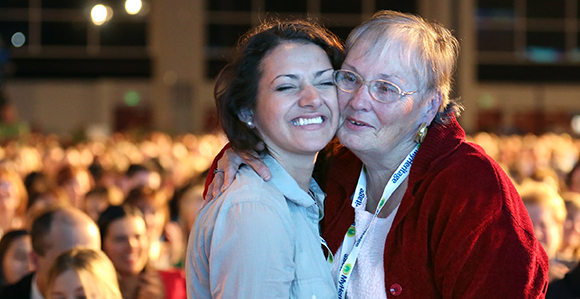
Mandy Phillips hugs her grandmother Ann Phillips during Family Discovery Day at RootsTech at the Salt Palace in Salt Lake City on Saturday, February 14, 2015. They shared their story of finding each other after 20 years apart.
Related Links
“Looking back prepares us to go forward,” said Elder Bradley D. Foster of the Seventy during a RootsTech session on February 14 in the Salt Palace Convention Center in Salt Lake City. More than 15,000 people gathered for the Family Discovery Day held as part of the conference to listen to General Authorities and auxiliary leaders and learn more about family history.
“The story of The Church of Jesus Christ of Latter-day Saints really is a story about families,” Elder Foster said. “And when I say families, I don’t mean our modern concept of Mom, Dad, and children. I use the term the way the Lord uses it, as a synonym for kindred or multigenerational families, because everyone has a family.”
Joining him in the session titled “Gathering, Healing, and Sealing Families” was Sister Linda K. Burton, Relief Society general president; Sister Bonnie L. Oscarson, Sister Carol McConkie, and Sister Neill F. Marriott, the Young Women general presidency; and Brother Tad R. Callister, Sunday School general president. Elder Foster invited his four daughters to the stage to introduce the participants and share stories of family history experiences in their own families.
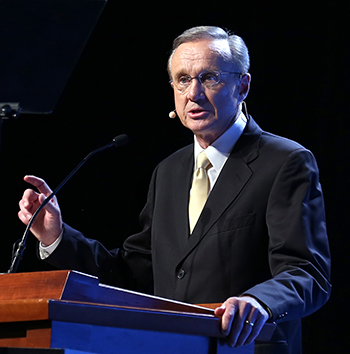
Elder Bradley D. Foster of the Seventy speaks during Family Discovery Day at RootsTech at the Salt Palace in Salt Lake City on Saturday, February 14, 2015. Photo by Kristin Murphy, Deseret News.
Drawing from the example of Lehi in the Book of Mormon, Elder Foster spoke of the importance of obtaining and preserving family records.
“Lehi’s family can teach us a great deal about family records, why they’re important to the Lord, and why they should be important to us,” he said.
Beginning with the story of Lehi and Sariah and their family in the wilderness, Elder Foster spoke of Lehi realizing he needed to go back to Jerusalem to retrieve the plates—plates that included his genealogical records. Rather than going himself, Lehi sent his sons to obtain the record.
“Have you ever wondered why the Lord didn’t command Lehi, rather than his sons, to go back for the record?” Elder Foster asked. “He was the patriarch of the family. The Lord gave him the vision. Wouldn’t Lehi have had more influence on Laban than his young sons? Yet the Lord commanded Lehi’s sons to go back to Jerusalem for the record—not Lehi.”
Although the sons struggled to accomplish the task the Lord asked them to do, they learned valuable lessons that would serve them well throughout their journey in the wilderness. They learned that when the Lord commands, He really does provide a way.
Drawing a comparison from that story in the Book of Mormon, Elder Foster spoke of inviting sons and daughters to learn by “going back” to retrieve their family’s records. “Are there experiences He wants them to have?” he asked. “How is He providing a way for them? Are we inviting them to have these experiences?”
As individuals look to the records of the past they are able to understand who they are in relationship to God and to each other. That understanding changes the way they think, how they act, and the way they treat others. Records are a vital piece of identity and perspective. By looking back at the records, they are able to be prepared to go forward, Elder Foster taught.
“Just as Lehi sent his sons back to Jerusalem for those sacred records, let us send our children back for our family’s records. … Just as the Lord provided a way for Nephi, He has provided the Internet and other technologies that will enable your children to find, … gather, and heal your family. And He has provided temples where we can take the names we find and make our gathering permanent through sealing ordinances.”
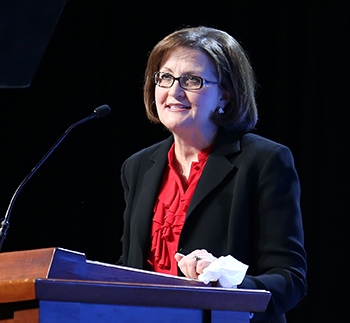
Linda K. Burton, general president of the Relief Society, speaks during Family Discovery Day at RootsTech at the Salt Palace in Salt Lake City on Saturday, February 14, 2015. Photo by Kristin Murphy, Deseret News.
Sister Burton spoke of the “small and simple things” that influence generations.
“Often, … the best family history stories are shared within the walls of our own homes—when we take the time to ask questions about our past or to share our own stories about ourselves and other ancestors,” she noted. “The work of family history can occur in ordinary times, like while riding in a car or during a meal.”
Just as it can take time to put the pieces of a large puzzle together properly, so does family history work.
“You all live busy lives,” Sister Burton said. “You take care of children or aging parents or work full-time jobs. You faithfully fulfill Church callings and serve your neighbors and in the community. Did you ever think that while you’re raising your children or caring for a parent that you’re actually creating family history? What you are doing is good. You are putting an eternal puzzle together piece by piece, receiving an inspired thought here and acting upon it, and then receiving a gentle nudge there and acting upon it.”
Sister Burton reminded listeners that no matter their family circumstance, they are not alone. Often it is through family history that individuals are able to find healing and help.
“You belong to a larger family,” she said. “You have many ancestors that have gone before you who went through similar trials. Get to know them, learn their stories, and share those stories with others.”
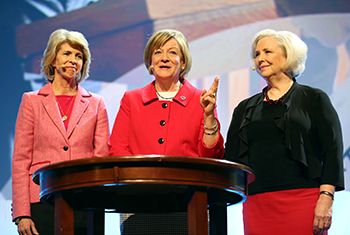
From left, sisters Carol F. McConkie, Bonnie L. Oscarson, and Neill F. Marriott of the Young Women general presidency speak during Family Discovery Day at RootsTech at the Salt Palace in Salt Lake City on Saturday, February 14, 2015. Photo by Kristin Murphy, Deseret News.
The Young Women general presidency invited the youth to “find, take, and teach.”
“The first step is to find the names of your ancestors,” Sister McConkie said. “This work is personal. You learn about the people in your family who came before you, people without whom you would not exist. We challenge you to seek, discover, and find the names and the remarkable stories in your own family.”
As individuals prayerfully seek, the Spirit of the Lord will guide them to find their family. After the names are found, it is important to take those names to the temple to perform ordinances on their behalf.
“Family history work is the work of salvation, so family history is clearly linked to the temple,” Sister Marriott said. “As you find the names of ancestors to take to the temple, you join with the Savior and therefore become unified in His mission to ‘bind up the brokenhearted, to proclaim liberty to the captives, and [to open] the prison to them that [are] bound’ (D&C 138:42).
“There is no greater work, no more significant way to spend your free time, than learning how to find the names of your ancestors who died without the gospel, taking those names to the temple, and teaching others how to do the same thing.”
Through finding names, taking them to the temple, and teaching others to do the same, individuals are able to strengthen their understanding of their true identity, give hope during hard times, and be a powerful source of spiritual protection.
“Learning the history of those who passed before you is learning about yourself,” Sister Oscarson said. “Your family’s history helps you understand who you are, where you came from, and the traditions and cultures that shape your life. It gives you a sense of belonging and creates a core identity that can be a great source of empowerment.”
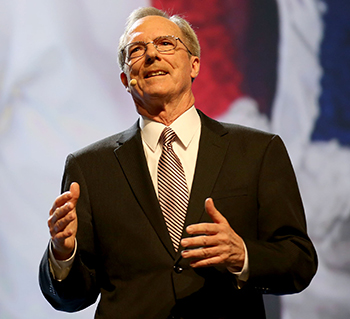
Tad R. Callister, general president of the Sunday School, speaks during Family Discovery Day at RootsTech at the Salt Palace in Salt Lake City on Saturday, February 14, 2015. Photo by Kristin Murphy, Deseret News.
Brother Callister spoke about people and ordinances—both of which are at the heart of family history.
“People become more real and relevant in our lives when we know their stories,” Brother Callister said. “Stories are a powerful means to convert a lifeless name to a living personality. They are an important part of finding in the family history process. Our stories have the power to be sermons without preaching. They can inspire us, entertain us, stir our emotions, connect our lives to others, bridge the gap of time and distance, and serve as a powerful motivating source for good. Stories of our ancestors can bind hearts between generations, increase love and appreciation for those who paved the way, and build our faith. They are an integral part of family history.”
Family history is more than searching out names of ancestors, Brother Callister taught.
“As important as that is, [family history] is also sharing insights and stories from their lives and our lives that knit our hearts together, it is taking their names to the temple and performing saving ordinances for them that advance their spiritual opportunities, and it is setting an example that is recorded in their hearts and reflected in their lives. As we share these faith-promoting stories with our children and grandchildren, participate with them in doing ordinances for our deceased ancestors, and teach them through our examples, we give many a worthy sermon without ever preaching.”
